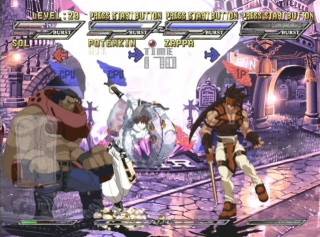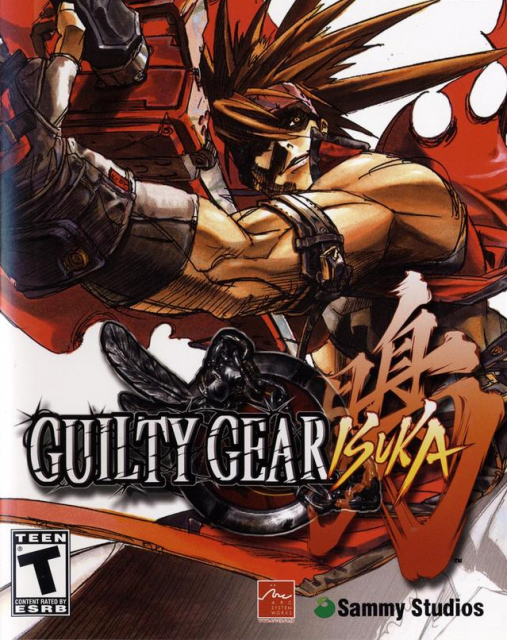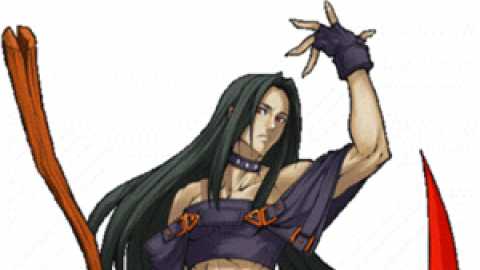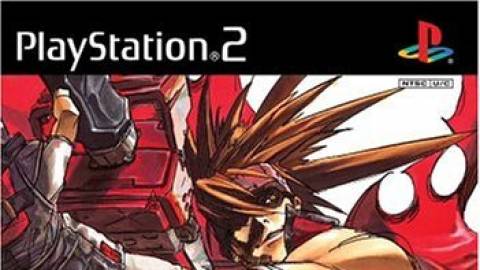Overview

Guilty Gear Isuka is a 2D sci-fi fantasy fighting game developed by Arc System Works and published by Sammy for arcades (running the Dreamcast-based Atomiswave hardware) on December 17, 2003.
A spin-off entry in the Guilty Gear series, Guilty Gear Isuka builds on Guilty Gear XX: The Midnight Carnival by allowing up to four players to fight each other simultaneously (either free-for-all or in team battles, both using a single-round lives system). This is compounded by a new two-line fighting system (similar to the Fatal Fury series), where players can switch between the foreground an background "lines" (or "planes") using a dedicated button (the "Turn" button, which is also used for turning the character, attacking opponents in the other line, and knocking opponents into the other line). A similar system was later implemented in Guilty Gear Dust Strikers.
The game was later ported to the PlayStation 2 on November 2, 2004 (published by Sammy in both North America and Japan, and by 505 in Europe). Japanese and European regions also received a port for the Xbox (published by Arc System Works in Japan and 505 in Europe) and PC (published by SourceNext in Japan and ZOO in Europe) between 2004-2006. The PC version was later digitally re-released worldwide on Steam (by KISS and Funbox Media) on January 16, 2014.
The console version received a new character to the series (artificial lifeform A.B.A.) and two new game modes: "GG Boost" (a two-player arcade-style beat 'em up in which players fight against waves of enemies to accumulate items, health, and experience) and "RKII Factory" (in which players can customize a special version of Robo-Ky by teaching it certain new abilities). GG Boost mode would later be expanded on in Guilty Gear Judgment.
Gameplay
Much of the game mechanics from Guilty Gear XX remain the same. However, there are some major differences, namely with the Two-Line Battle system. Some of these changes include:
- Replacing the fifth "Dust" button with a new utility Turn button. It is used for manually turning the character (as it is no longer performed automatically) and performing Line-specific actions.
- All attacks related to the Dust button are now performed by pressing both Slash buttons together (S + HS). Psych Bursts are now performed by pressing all four attack buttons together (P + K + S + HS) and are uniform (with all of the Gauge consumed and the Tension Gauge refilled on hit).
- Up to four players can play at once, with each player selecting one of four teams (represented by color arrows). The game now uses a single-round lives system, where each team has a limited amount of "souls" that are each expended for a full health recovery once a team's character is knocked out. If the match timer runs out, the team with the most Souls remaining wins, with ties furthering it down to the team with the most Health remaining.
- Instant Kills have been removed.
The base arcade game, as well as the Arcade Mode in the console version, is based on the Survival Mode in the console versions of Guilty Gear XX. Players play a seemingly-endless series of 1v1 matches while upgrading their "Level" (by attacking opponents). At Levels 20, 40, 60, 70, 80, and 90, the game is interrupted and players instead fight a team of two opponents. At the maximum Level (99), the game is interrupted and players fight a final match against Leopaldon before the game ends.
Two-Line Battle
Traditionally, Guilty Gear is a one-on-one fighting game in a single 2D fighting "Line" (or "Plane"). Guilty Gear Isuka changes this to a pseudo-3D setup with two 2D fighting Lines (a foreground Line and background Line).
The game includes some new techniques that make use of this system:
- Back Attack (K + S) - Attacks behind the character without turning.
- Line Change (T + HS) - Switches between Lines. Can be performed while guarding (costing 25% of the Tension Gauge).
- Line Change Attack (T + P) - Switches between Lines while attack
- Line Blow (T + S) - Attack that knocks the opponent into the other Line.
Characters
New Additions
- Leopaldon (final boss, only playable as an unlockable in the console version) - A hulking Gear with a dog head (which is revealed to be an actual large dog) who is piloted by a mysterious "sorcerer".
- A.B.A (added in the console version) - An artificial lifeform from Frasco, who lived in total isolation for 10 years before escaping using an ancient war relic shaped like a large key (the "Flament Nagel", who she renamed to "Paracelsus").
- Zako-A (minor enemy in the console version's GG Boost Mode, only playable in that mode as an unlockable)
- Zako-B (minor enemy in the console version's GG Boost Mode, only playable in that mode as an unlockable)
- Zako-C (minor enemy in the console version's GG Boost Mode, only playable in that mode as an unlockable)
Returning Fighters
- Sol Badguy (has an unlockable "Kakusei" version in the console versions)
- Ky Kiske (has an unlockable "Kakusei" version in the console versions)
- Millia Rage
- Zato-1
- Potemkin
- Faust
- Chipp Zanuff
- May
- Axl Low
- Testament
- Baiken
- Johnny
- Anji Mito
- Jam Kuradoberi
- Venom
- Dizzy
- Zappa
- Bridget
- Slayer
- I-No
- Robo-Ky (added in the console version, has an alternate "Robo-Ky II" version that is customizable in "RKII Factory" mode)
System Requirements (PC)
Minimum
- OS : Windows XP / Vista
- Processor : 1 GHz processor
- Memory : 256 MB RAM
- Graphics : 3D graphics card compatible with DirectX 8.1
- Hard Drive : 471.1 MB available space
Recommended
- OS : Windows XP / Vista
- Processor : 1.4 GHz processor
- Memory : 512 MB RAM
- Graphics : 3D graphics card compatible with DirectX 9
- Hard Drive : 471.1 MB available space


 PlayStation 2
PlayStation 2 Xbox
Xbox Arcade
Arcade PC
PC



